Driver Cooling
#1
Pro


Thread Starter
After two days at VIR I have decided it is time to look at add'l driver cooling. I have a cool shirt but am looking at someting to keep head and face cooler. I have been thinking about a blower helmet that runs cool air from the cool shirt box. Does anyone have any feedback on this type of set up? Does it work for a full 30 - 40 min session or does the cooling go away quickly? As I get older the heat seems to be more of a problem. I have tried running the duct from the window to driver area but I can't seem to get any air into the car. Any ideas ???
#2
Burning Brakes


I started with only the FAST helmet cooling and that was a great imporvement over nothing. I now have the cool shirt and helmet cooling. The shirt provides far more comfort than the helmet, but I would recommend both for the temps and humidity we have in the Southeast.
Newer helmets are available with improved distribution of the cool air, so you would get even more benefit.
Newer helmets are available with improved distribution of the cool air, so you would get even more benefit.
#3
Le Mans Master


The cooling to the helmet will work as long as the ice in the cool box remains. The best way to accomplish this is by using a block of ice instead of crushed cubes. Sometimes this is hard to accomplish depending on your lodging arrangements at various tracks and access to a freezer. If you have a freezer, you can saw off the top of a plastic milk carton or use a large piece of Tupperware.
I have an inlet in the passenger side rear Lexan window to draw in air straight to the unit. You could fabricate a Lexan piece for the passenger side window with the same inlet.
If you don't want to go to that extreme -- forum member Snitz, who built a car like mine with C5 bodywork simply uses duct work that is zip tied just inside the side view mirrors, this would allow you to not really alter anything. I'll be at the track later in the week to get some photos for you.
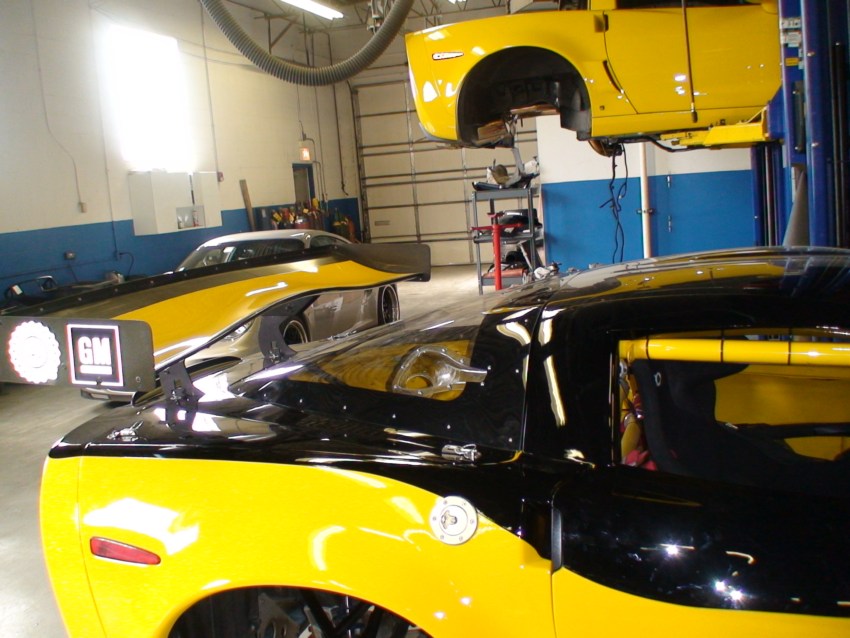
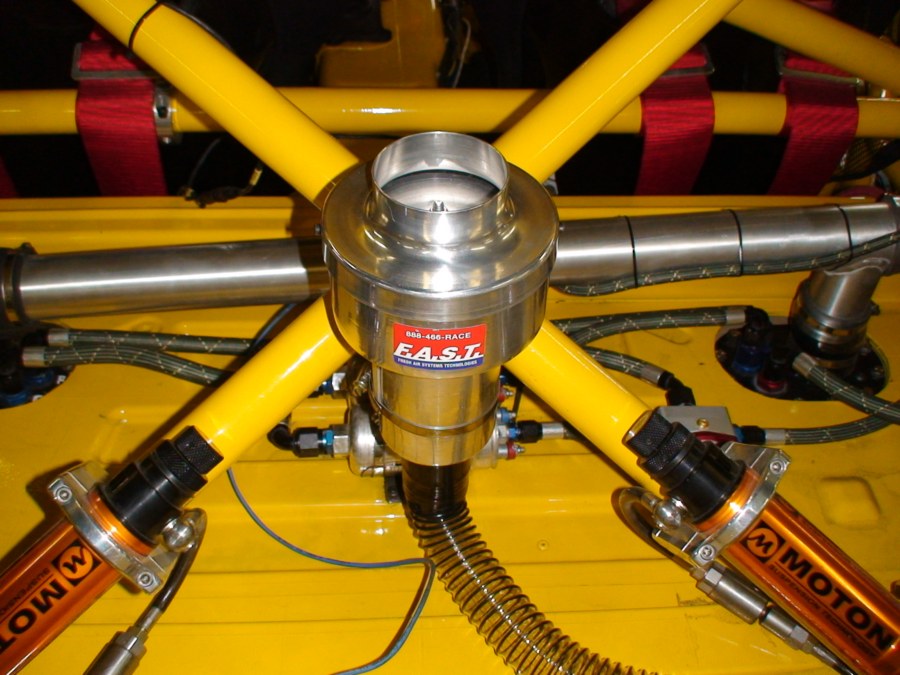
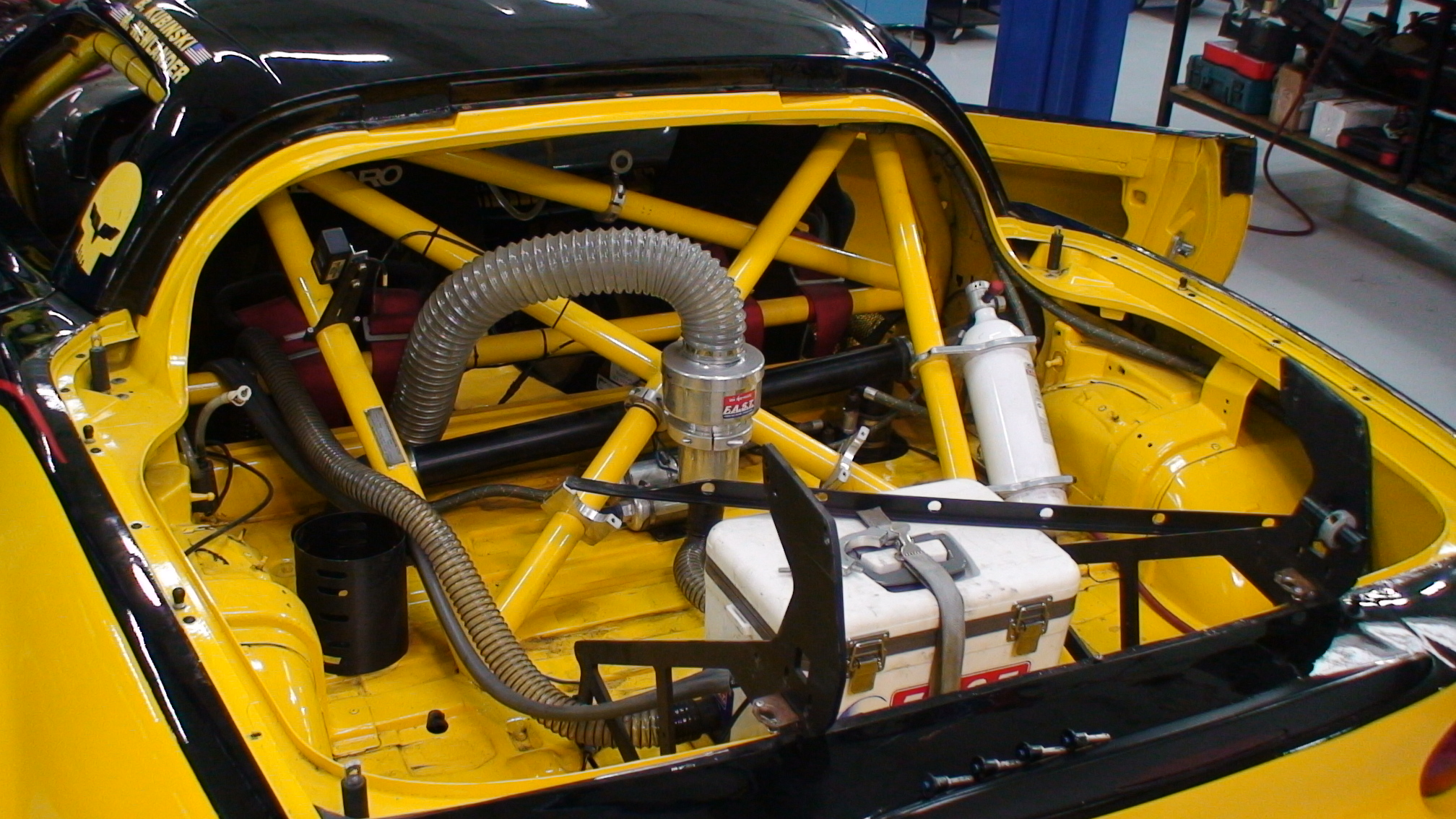
If you want unlimited cooling, there are newer units available now that require no ice, simply add water, but the cost is very high, 8-10K as they have an actual condenser.
Here's a cheaper option of such a product, but still pricey:
An article from last year: Arctic Racing Air
http://www.circletrack.com/safety/ct...g/viewall.html
Race Car Air Conditioning - Chilled Like No Other
Circle Track takes a look at the brand-new Arctic Racing Air cooling system, a first of its kind
From the October, 2011 issue of Circle Track
By Todd Ridgeway
Staying cool in the race car always has been, and always will be, a very big deal to any driver or race team in the business. The driver's core body temperature has a direct effect on his or her on-track production. That production comes in the form of race results along with a driver's decisions, good or bad. But it almost always hinges on the performance of the guy or gal behind the wheel and their comfort zone. More often than not, staying cool means staying mentally alert and in control ready for any situation. Even when the outside temperature is cool, it can still be a very hot seat in the race car. Drivers make split second decisions in the blink of an eye and any effort made to help make the right decision is an added plus for the race team.
Hart Design and Fabricating, or just Hart as most know it, is a product design and development company based out of Indiana. While originally started to design high-end Motor Coach products, company owner Jamie Hart also had a drag racing background which eventually led him down the path of designing racing related products. On that journey customers and fellow racers began to ask for a new cooler air system with better, colder, and more reliable airflow. Hart conceptualized a system that would provide the race car driver with cool, filtered airflow keeping him more alert, which would translate into safer performance on the track. In order to achieve that Hart knew that he had to employ a true Freon-based air conditioning system.
Thanks to Hart's racing background he knew how important horsepower was to a race team. He knew he had to design a system that would not only care for the driver, but have a minimal impact on the horsepower. The solution? Use less of the available amperage already in the car. So, Hart, along with VP of Operations John Hoffman, set out to work.
By 2008 they had put together a prototype for a test. That test took place in the Mitler Brothers NASCAR Camping World Truck team at Texas Motor Speedway both during a test session and in an actual race. Though the initial results were positive they knew they had to refine the product before bringing it to market. The finished product, introduced just last year, is quite a system.
Officially dubbed Arctic Racing Air, the system's design incorporates the same thermodynamic technology found in air conditioning systems found in your home or street car. Coupled with cutting edge software driven microcontroller electronics developed in house, the whole system draws less than 1/3 the amperage of a conventional system while delivering twice the airflow and temperatures up to 10 degrees colder. The system is so efficient that there is no need to up the amperage on the alternator. Low power consumption means you can use more horsepower for what matters most. Plus, all units are plug-and-play for quick and easy installation.
Of course, delivering all that cold air to a hot driver is the second part of the equation. The Arctic Racing Air System's airflow is routed into an exclusive Impact Spider Induction Helmet System. Prior to selling his company to MasterCraft Safety, Bill Simpson was instrumental in designing the helmet liner Hart would use to fit the Arctic Racing Air system. The liner resembles a shower head, with numerous small holes surrounding your whole head. Instead of having airflow in just one area (usually the top) the multi hole design surrounds the entire head in air. The Impact Spider Induction System allows cool air to circulate fully and evenly around the head and neck, which in turn will keep the driver more alert during the heat of competition.
The cooling provided by the Arctic Racing Air is equivalent to an 800-Btu air conditioning system. With the air flowing at a rate of 40 cfm (more than double a conventional system), a driver truly can feel the difference. Best of all, both the temperature and airflow are easily driver adjustable.
The system comes complete with a three-position smart switch panel. The PWR switch allows you to choose between a fan-only setting and the A/C setting. The fan-only setting uses just 2.5 amps of power and can be used anytime A/C is not required or desired, but when you still want constantly filtered, fresh airflow to the driver's helmet.
The other two switches, FAN and TEMP, allow you to control how fast the air blows into the helmet, as well as how cold it is. The FAN switch controls the speed of the airflow with the Lo setting providing 20 cfm, Med delivers 30 cfm, and Hi blasts you with 40 cfm.
The TEMP switch controls the temperature of the airflow discharged into your helmet and works just like a thermometer. The Lo setting is the coldest, Med is in the middle, while Hi would be the warmest, or should we say least-cool, setting. The maximum temperature drop the unit can provide is 30-35 degrees below ambient temperature. To achieve that on the highest/coldest setting, the unit will only draw 9.5 amps.
It has a replaceable, disposable Merv 11 filter that removes dust, smoke, and rubber particulate down to 1-3 microns with more than 95 percent arrested. And the optional Track Fresh Carbon Monoxide Filter removes up to 75 percent of the CO, all before it gets to the driver! You truly are breathing clean air.
So How Does It Work?
Hart is an active sponsor in the ARCA world and more specifically in the ARCA Truck division where the company picks a truck at each race to install its unit as the drivers take turns using the system. This provides Hart on-track diagnosis while still providing the racers with some new technology to use. The Hart reps are at every race to help with understanding and proper installation.
One group that jumped on the system early on is the Young Family's Glass City Motorsports out of Toledo, Ohio. It uses the system in both the ARCA Truck Series as well as ARCA's marquee series presented by Menards. This family team—with driver, Mike (son), and crew chief, Paul (father)—probably have tested and raced the unit more than any others in the ARCA garage. They put the system to test in May of this year at Toledo Speedway in both the truck and the car.
"Two weeks ago we used it in our ARCA Truck Series test at Flat Rock Michigan," notes Paul. "The temperature outside was approximately 75 degrees but the inner cab of the truck was 105 degrees. We tried it without the A/C the first time around. Then during the second session we went out and only turned the fan on for 15 laps. We came in and the driver had no sweat on his face and his neck was cool."
But the third session was telltale of what the system can do. "In the third session out, we turned it on to air ‘Lo' and the driver actually said he was cold at those temperatures."
After 200 laps around Toledo, Mike Young was sold on the Arctic Racing Air System. "The system is really easy to work with; the panel is real easy," stated Young. "I had it on ‘Lo' and ‘Fan' for the first part of the race and I actually started to get a little cold. I shut it off, started getting warm and turned it right back on. My head was cool, the top part of my neck was cool, and I had full concentration on the race."
"There are three switches, one for A/C, Off, and Fan; another for Hi, Medium, and Lo; and the third for Temp. The panel is easy to read and just a quick flip on and off even with the gloves on. The confidence as a driver means a lot. The head stays cooler, you're getting more blood flow, not getting dehydrated. I mean, I barely even drank out of my bottle today. The weather may not have been as hot, but man, it was still hot in that race car. It's just a pretty easy system to adjust to and work with. I will be using the system in both my ARCA car and truck this season," finished the young racer.
The Youngs said that installation only took about 2 1/2 hours and wasn't at all difficult. "Fabrication of the hoses and the duct work is probably the hardest part," said Paul Young. "You can buy all that stuff, but I made my own. In the truck it was easy, in the car it was a little more difficult because of the room in the car, they have a lot of stuff inside."
The complete system weighs in at about 20 pounds but that didn't bother crew chief Paul. "To adjust for the weight in the ARCA car, I took 25 pounds out of the right side rail. With the hoses and everything, the system weights about 22 pounds. I am not worried so much about the right-side weight hurting me, I figure as long as the driver is comfortable at the end of the race as at the beginning, the lap times will show it. A lot of times consistent lap times are what wins a race. If he is comfortable then the fatigue is not there.
"The box itself is advertised at 9 amps; I did a personal test and it came in at about 9.2 amps. Compared to others that draw 28 to 29, that's nothing," says Paul. "I believe there is a lot of room for this box, and with the low amperage they would not have a battery issue."
The Installation Process
The whole system is also fitted with quick release connections to make for quick and easy installation. Since it is, in essence, an air conditioner, it must be mounted as level as possible with the condenser discharge air unobstructed. The condensate drain (clear vinyl tube) needs to be allowed to drain off the condensation that forms on the evaporator coil during use. Arctic Air recommends the condenser air inlets (large inlets on top of unit) be connected to an outside air source outside of the driver's compartment, but it's not mandatory. It depends on the compartment air temperature. For maximum cooling, the helmet air inlet (large inlet on end of unit) should be connected to an NA/CA duct for inletting of outside fresh air.
The Driver's Control Switch panel should be mounted within the driver's arm reach and vision for quick-glance access. The main power cable can be connected to either the main power shutoff switch or directly to the battery. It can even be wired so the driver may operate the unit while the vehicle is stationary and not running. It's that simple.
The passion behind the Arctic Racing Air System was to provide a better airflow system and colder air, while also making it affordable to the racing community. The new system carries an introductory cost of $3,500, less the Impact helmet. Like everything, it's only natural that as the technology improves and adjustments are made the price will decrease.
So, in the end we're left with a very nice, more than adequate airflow unit at a competitive price, with twice the airflow and 10 degrees colder temps. With less than 1/3 of the amperage draw of other units, the system leaves more horsepower for the racer. And isn't that what we all want?
Once you get a system that delivers the cooling to your liking, you won't care how much it cost, it really is worth it.
Mike
#4
Le Mans Master



On a 110* day at Road Atlanta, it's the best blow job you'll ever get going down the S/F straight.

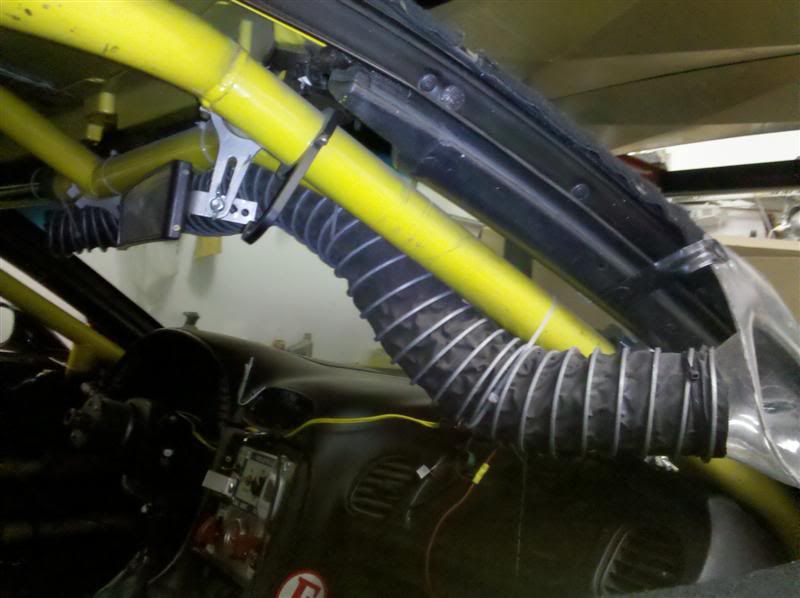
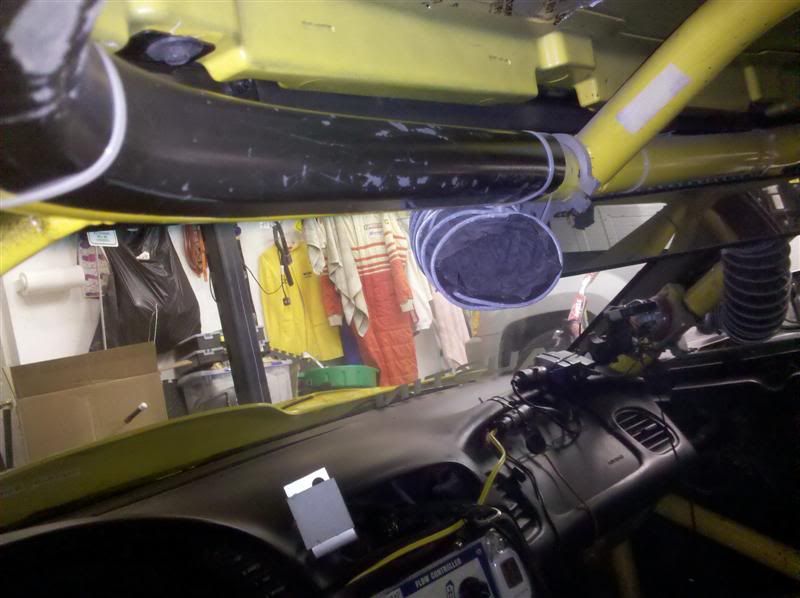
#5
Le Mans Master


Jody, what are you basing your blow job experience off of when you say this is the best?
I agree. This is what I was referring to in Snitz's car, very inexpensive and effective. If you want a helmet connection, just take this duct work to the blower setup through the cool box and run a hose from the box to your helmet.
Mike
I agree. This is what I was referring to in Snitz's car, very inexpensive and effective. If you want a helmet connection, just take this duct work to the blower setup through the cool box and run a hose from the box to your helmet.
Mike
#6
Le Mans Master



#7
Racer


I was having some heat issues too. I asked for help. Jody and Beretta showed me their set ups. I took what they did on their race cars and made mine. I still have the windows in the doors so I needed my Naca ducting to be recessed back a little. I backed up the system with an inline 235 CFM blower. I have the ducting routed through the main vent on the dash to blow at me. It works great.
I took what they did on their race cars and made mine. I still have the windows in the doors so I needed my Naca ducting to be recessed back a little. I backed up the system with an inline 235 CFM blower. I have the ducting routed through the main vent on the dash to blow at me. It works great.

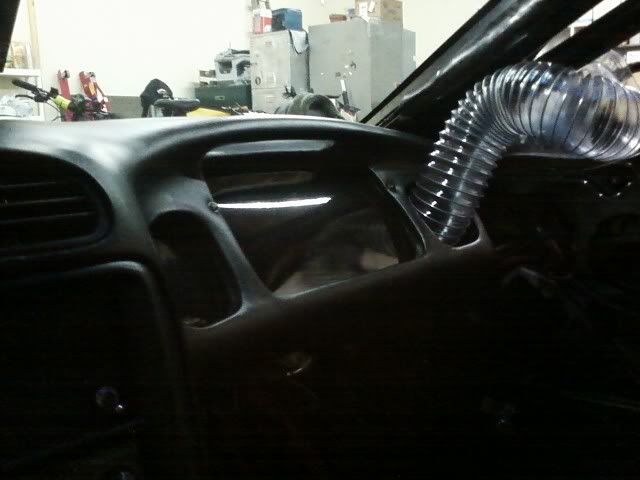
I have a toggle switch for the cool suit and the blower on the dash. Plus I rerouted the traction control button.
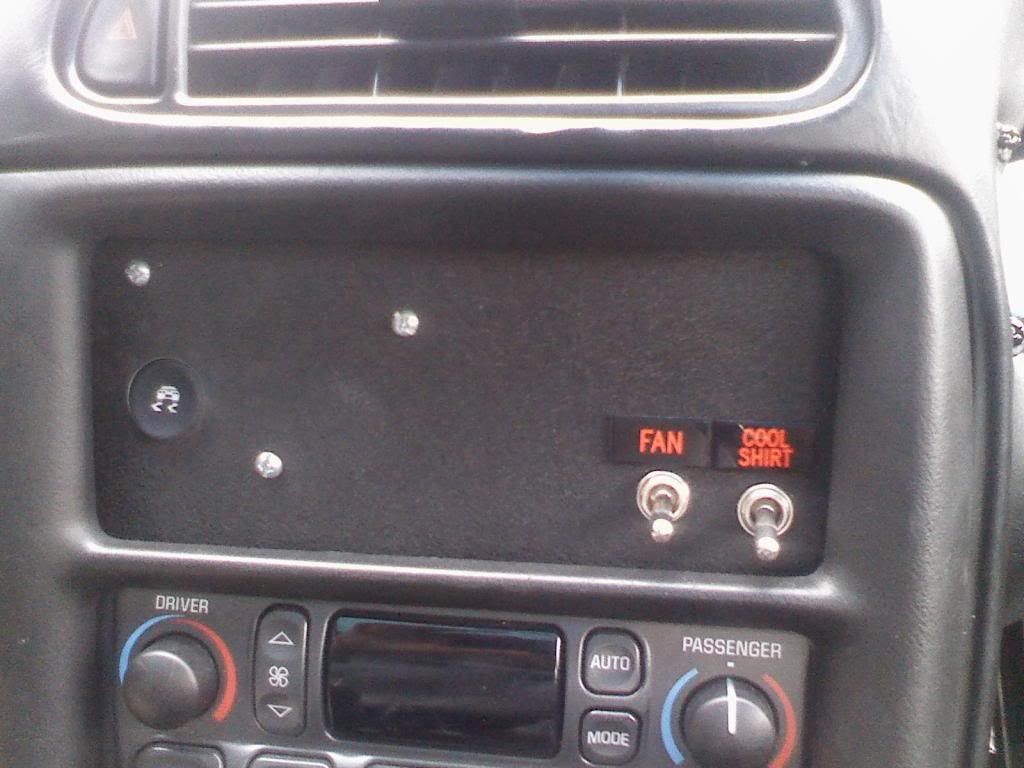
Here's a picture of when I was installing it. You can see the fan and the direction of the ducting.

 I took what they did on their race cars and made mine. I still have the windows in the doors so I needed my Naca ducting to be recessed back a little. I backed up the system with an inline 235 CFM blower. I have the ducting routed through the main vent on the dash to blow at me. It works great.
I took what they did on their race cars and made mine. I still have the windows in the doors so I needed my Naca ducting to be recessed back a little. I backed up the system with an inline 235 CFM blower. I have the ducting routed through the main vent on the dash to blow at me. It works great.

I have a toggle switch for the cool suit and the blower on the dash. Plus I rerouted the traction control button.

Here's a picture of when I was installing it. You can see the fan and the direction of the ducting.

Last edited by Paul Schmidt; 07-01-2012 at 05:42 PM.
#8
Le Mans Master



Holy Magnifico! What a great job! 
Some of you guys got talent. I attack things with a meat cleaver, while you guys use a scalpel!
Good job!

Some of you guys got talent. I attack things with a meat cleaver, while you guys use a scalpel!
Good job!

#9
Drifting


[QUOTE=Falcon;1581207307]I tried the duct in the back of the passenger window and got no air to me. I moved the duct to the front of the passenger window, just behind the rear view mirror, and it's like sitting in a hurricane now. It's surprising how much difference moving the duct from rear to front made.
On a 110* day at Road Atlanta, it's the best blow job you'll ever get going down the S/F straight.

QUOTE]
What duct is this?
Thanks..
On a 110* day at Road Atlanta, it's the best blow job you'll ever get going down the S/F straight.

QUOTE]
What duct is this?
Thanks..





